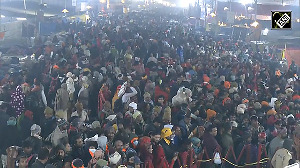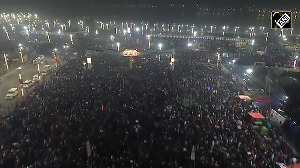In the early 1980s, the British peace movement, then at its peak, invented a delightfully imaginative phrase to highlight the skewed and unequal character of the Anglo-American defence relationship.
Britain, it said, was America's 'Unsinkable Aircraft Carrier'; that's how the United States looked upon its closest military ally. The peace campaign showed how this 'security partnership' actually exposed Britain to greater risk and insecurity. This triggered a series of anti-nuclear protests, including a heroic years-long struggle at Greenham Common.
Although he was an arch-conservative, Winston Churchill had the foresight to warn in 1950: 'We must not forget that by creating [an] American atomic base... we have made ourselves the target, and perhaps the bull's eye of a Soviet attack'. Thirty years later, British Defence Secretary Francis Pym had to admit: 'The Russians, let everyone understand, can annihilate Britain easily, ten times over'.
Fifty three years later, Britain again committed an identical mistake -- by joining the US in invading Iraq on falsified evidence about weapons of mass destruction (WMDs). Last week, it paid a horrible price through the loss of innocent lives in utterly condemnable terrorist bombings. The bombings are attributable to Britain's intimate military alliance with the US and its participation in Iraq's occupation -- against the force of public opinion.
India may be about to replicate Britain's blunder. So it would seem, going by the extremely controversial 'New Framework for the US-India Defence Relationship' signed by Defence Minister Pranab Mukherjee on June 28. This has provoked spirited protests from the Left and created immense unease in the ruling United Progressive Alliance.
Mukherjee has tried to make light of the agreement by saying it's not a treaty or a pact. But that's unlikely to wash. As Prime Minister Manmohan Singh visits the US, even more uncomfortable questions will arise about the wisdom of such "strategic partnership".
The Manmohan Visit: History Beckons
The "framework" is deeply skewed and fetters India from taking independent action in international affairs and strategic matters. One needn't be a national-chauvinist or a votary of inveterate anti-Americanism to say this. The agreement's objectives include 'defeating terrorism and violent religious extremism', 'preventing the spread of WMDs and associated materials...', and 'protecting the free flow of commerce via land, air and sea-lanes'.
India of course has an interest in 'defeating terrorism', but it should know the US is often part of the problem, not the solution. Washington's reckless or unbalanced actions typically aggravate the grievances which feed terrorism. It relies on that ultimate form of terrorism, WMDs, for "security". It supports/condones state terrorism when that's expedient.
The US prescribes an "us"-and-"them" approach to fighting terrorism. It alone defines what constitutes the "spread of WMDs". Yesterday, this happened in Iraq; tomorrow, equally falsely, it might be in Iran. India will undermine its own policy independence by agreeing to this formulation. India has never advocated promotion of "free commerce" by military means, or subordinated trade to sovereign national rights to territorial waters/airspace.
Even more questionable is the "framework's" Clause 4, about collaboration in "multinational operations", without as much as a reference to the United Nations, which alone can authorise such operations in the interests of peace and security. This fully conforms to America's unilateralism and contempt for international consensus, but is against India's long-standing multilateralism, with emphasis on the UN. The text studiously bypasses the UN.
Sub-clauses 4C, D & E say the US and India will collaboratively strengthen their military capabilities "to promote security", "expand interaction with other nations", and "enhance capabilities to combat [WMD] proliferation". They will also "conduct exchanges on defence strategy" and "increase exchanges of intelligence". This spells an exclusive relationship to undertake joint expeditions. It bears emphasis that the US always demands total control over all joint operations: there's only one finger on the trigger!
The rationale of joint operations was recently set out in a closed-door briefing in New Delhi by a visiting US official (The Hindu, July 1): "The worst outcome for the US is an Asia from which we are excluded". The key challenge for the US, he said, is to "remain engaged everywhere and not allow any other industrial power to dominate a given region... If I were China... I'd be working on kicking the US out of Asia... Right now, we have a lot of alliances but there is no architecture embedding us in Asia. This worries us".
India is the anchor through which the US wants to embed itself in Asia, and among other things, to counter China. India is being recruited to serve that aim. The US would also like to establish control over the Malacca Straits through India's "partnership". But India will only court the hostility of countries like Indonesia and Malaysia, which oppose external forces in Malacca.
Jointly preventing the "spread of WMDs" is likely to take the form of Indian participation, under US pressure, in the Proliferation Security Initiative, an agreement among a handful of Western states to intercept suspect WMD-related shipments on the high seas. India's participation in PSI will bring her into conflict with many Asian states which oppose it, including China, Iran, Malaysia and Indonesia. High-seas interdiction of ships is against the Law of the Seas. India's participation will legitimise the US's role as the world's principal self-appointed gendarme.
Even worse is Clause 4J, under which the two states "assist in building worldwide capacity to conduct successful peacekeeping operations, with a focus on enabling other countries to field trained, capable forces for these..." It doesn't take much intelligence to understand where these "operations" might occur (without UN authorisation, of course), and which are these "other countries". The reference is obviously to Iraq, from where the UN and Britain are reportedly planning to withdraw substantial numbers of troops as they come under increasingly lethal fire, and substitute them with Indian cannon fodder. The Indians can "stabilise" the raging insurgency and train the Iraqi army and police.
The US has long had its eye on India's abundant human resources, including its military manpower, which it has assessed through joint exercises since 1992, leading to "inter-operability" of troops and communications. Washington wants to recruit Indian troops as subaltern elements or pawns in its global military operations -- much in the way the British-Indian army was exploited to expand the Empire into the Middle East and Afghanistan.
In fact, unabashed apologists for the Empire like Niall Ferguson make that very comparison. Britain needed 130,000 troops to subdue Iraq in 1920, when Iraq's population was three million. To "stabilise" today's Iraq, with its 24 million people, the US will need at least one million troops. (It has only 138,000.) So Ferguson pleads: recruit more US soldiers by lowering education requirements, or accelerate citizenship for immigrants who join the Army, or send Condoleezza Rice to Delhi!
As reward for converting the Indian Army into a mercenary force, the US holds out three carrots: support for India's bid for a permanent seat on the UN Security Council; sales of armaments and the promise of co-production; and "collaboration relating to missile defence". However, the new council members won't have the veto -- the G-4 have already agreed to this. It's also unclear if the G-4 will win the UN vote, especially if the US divides the Group by opposing Germany and Brazil. So even a second-rate seat may remain illusory!
The only concrete US arms offer is for the 1970s-generation F-16 warplane. But the aircraft's utility and appropriateness for India is in doubt. It doesn't dovetail into any existing weapons platforms; its induction will entail huge maintenance expenses. The only beneficiary of F-16 sales will be the US manufacturer, Lockheed Martin. The corporation says: 'If we don't get any more F-16 orders by 2005, we would have to take action to close the [production] line...' As for co-production and technology transfer, this is only a promise. The US is, typically, extremely reluctant to transfer weapons technology. In 1986 too, it offered India co-production, but nothing happened.
Missile defence is a fraught subject. India's stated position rightly opposes Ballistic Missile Defence because this will undermine even nuclear deterrence and make the world more insecure. It will also lead to the militarisation of space. BMD weapons seek to destroy enemy missiles in space before they re-enter the atmosphere to hit terrestrial targets. Defence Minister Jaswant Singh welcomed Bush's BMD plans in 2001. But he had no mandate to do so. The UPA must reject that misconceived approach.
The 'New Framework', then, is unbalanced and skewed. It can only lead to India's co-optation as a junior partner or client of the US, and erode its autonomy, dignity and independence. India will only succeed in making enemies out of its immediate neighbours and Southeast Asian friends. The 'framework' mocks at the UPA's promise to promote multi-polarity in the world. The National Common Minimum Programme says: 'Even as it pursues closer engagement and relations with the US, the UPA government will maintain the independence of India's foreign policy positions on all regional and global issues'. The 'framework' completely negates this. It must be scrapped.






 © 2025
© 2025